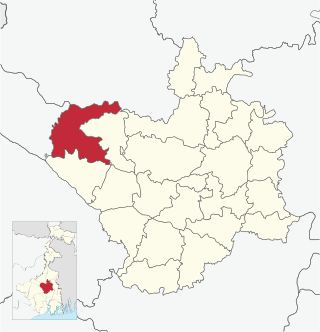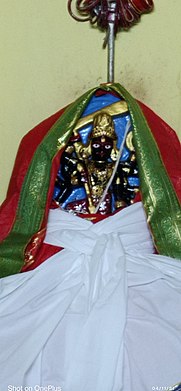
Bardhaman district was a district in West Bengal. On 7 April 2017, the district was bifurcated into two districts: Purba Bardhaman and Paschim Bardhaman district. The headquarters of the district was Bardhaman, and it housed the cities of Asansol and Durgapur. Indian revolutionary Rashbehari Bose was born in village Subaldaha, Bardhaman district. Bengali poet Kumud Ranjan Mullick was born at Kogram and poet Kazi Nazrul Islam was born at Churulia in the same district. Notable persons like Prabhat Kumar Mukhopadhyay, Akshay Kumar Datta, Jatindranath Sengupta were also born in erstwhile Bardhaman district. It was the seventh most populous district in India at the time of bifurcation.
Kanksa is a census town and a gram panchayat in the Kanksa CD block in the Durgapur subdivision of the Paschim Bardhaman district in the Indian state of West Bengal.
Keshiary is a village in the Keshiari CD block in the Kharagpur subdivision of the Paschim Medinipur district in the state of West Bengal.
Bud Bud is a census town in Galsi I CD Block of Bardhaman Sadar North subdivision of Purba Bardhaman district in the Indian state of West Bengal.

Bardhaman Sadar North subdivision is an administrative subdivision of the Purba Bardhaman district in the state of West Bengal, India.
Monteswar is a village situated in Manteswar CD block in Kalna subdivision of Purba Bardhaman district in the Indian state of West Bengal.

Galsi is a village in Galsi II CD Block in Bardhaman Sadar North subdivision of Purba Bardhaman district in the state of West Bengal, India.

Ausgram II is a community development block that forms an administrative division in Bardhaman Sadar North subdivision of Purba Bardhaman district in the Indian state of West Bengal.
Ketugram is a village in Ketugram II CD block in Katwa subdivision of Purba Bardhaman district in the state of West Bengal, India.
Kogram is a village in Ketugram I CD block in Katwa subdivision of Purba Bardhaman district in West Bengal, India.
Ausgram is a village in Ausgram I CD block in Bardhaman Sadar North subdivision of Purba Bardhaman district in the state of West Bengal, India.
Kamnara is a village in Burdwan I CD block in Bardhaman Sadar North subdivision of Purba Bardhaman district in the state of West Bengal, India.
Madhabdihi is a village in Raina II CD block in Bardhaman Sadar South subdivision of Purba Bardhaman district in the state of West Bengal, India.
Sagrai is a village in Khandaghosh CD block in Bardhaman Sadar South subdivision of Purba Bardhaman district in the state of West Bengal, India.
Mongalkote is a village in Mongalkote CD block in Katwa subdivision of Purba Bardhaman district in the state of West Bengal, India.
Nutanhat is a village in Mongalkote CD block in Katwa subdivision of Purba Bardhaman district in the state of West Bengal, India.
Mirzapur is a census town in Burdwan I CD Block in Bardhaman Sadar North subdivision of Purba Bardhaman district in the state of West Bengal, India.
Nari is a census town in Burdwan I CD Block in Bardhaman Sadar North subdivision of Purba Bardhaman district in the Indian state of West Bengal.

Gourangapur is a village in Kanksa CD block in Durgapur subdivision of Paschim Bardhaman district in the Indian state of West Bengal. The place has links with Ichhai Ghosh, king of Gopbhum, and it is believed that his capital, Dhekur, was located nearby. The area was earlier a part of Senpahari pargana.

Gopbhum or Gopbhumi is a historical region of West Bengal state in Eastern India. It included the entire area between the Ajay and Damodar rivers, which is present-day Purba Bardhaman, Birbhum, Jamtara, Purulia and Paschim Bardhaman districts of West Bengal. English translation of the word 'Gopbhum' is 'The land of Gopa'.










